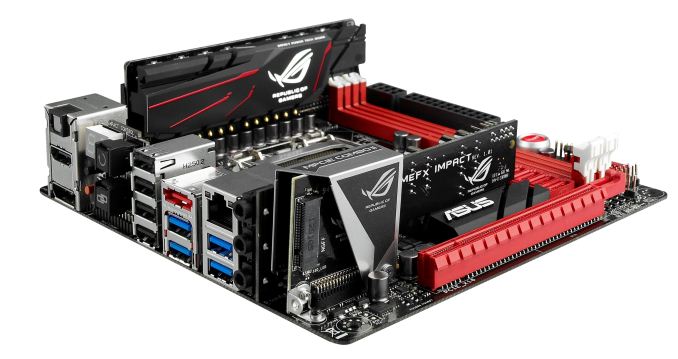ASUS Maximus VI Impact Review: ROG and Mini-ITX
by Ian Cutress on November 22, 2013 10:00 AM ESTASUS Maximus VI Impact Conclusion
When looking at the hardware on the Impact, it is hard not to be impressed. ASUS are now a couple of generations into their daughterboard power delivery design, and migrating features such as the audio, the WiFi and M.2 support to add-in PCBs is another step above what other motherboard manufacturers are providing in terms of innovation.
Hardware wise, aside from the 60A Blackwing chokes, we get SupremeFX audio, an Intel NIC, dual band 802.11ac WiFi with BT4.0, NGFF M.2 support, power/reset buttons, a two digit debug on the Impact Control rear IO PCB, four SATA 6 Gbps ports, a total of six USB 3.0 ports, and four 4-pin fan headers.
Software starts with the ROG themed BIOS, suitable for any extreme overclocker and tweaker to get their hands dirty, especially with customizable menus and a number of options on display. New to Z87 ROG is ROG Secure Erase, a feature that allows users to Secure Erase their SSD, without software or a Linux distro to bring performance back. On the OS side, AI Suite is now in its Z87 iteration using 4-Way Overclocking to bring an automatic overclock to the system. Alongside TPU and EPU, Sonic Radar is a new feature, one that provides a visual representation of directional audio in games. While with limited testing I did not find it all that helpful (and caused a consistent FPS dip due to the audio/video interposing it has to do), I can imagine situations where it can make a difference. There is also GameFirst II, the network management software, and ROG RAMDisk, that circumvents any $20 RAMDisk purchase for any size RAMDisk, limited by the amount of memory in the system.
There are a couple of niggles and gripes with the Impact to go along with the positives. First is the price – it tips the scales as the most expensive Z87 mini-ITX board on the market:
$225 – ASUS Maximus VI Impact
$220 – EVGA Z87 Stinger (in for review)
$190 – ASUS Z87I Deluxe (in for review)
$140 – ASRock Z87E-ITX (recommended award)
$135 – GIGABYTE Z87N-WiFi
$130 – MSI Z87I (reviewed)
Most of the pricing behind the Impact is sensible, with it featuring high end hardware and software as part of the package. If you just wanted something to put a processor in, then ROG is not aiming for that audience.
One feature I mentioned in the review was a lack of SATA 6 Gbps ports, suggesting that users might be wanting to add some proper storage to their gaming platform. The motherboard has an M.2 and four SATA ports, suggesting that a 1TB SSD, an ODD and three drives might be sufficient. Users wanting RAID 5, three disks would be a minimum but four makes it a bit sweeter: ASUS like to mention that the Z87-I Deluxe is more suited to a storage build.
There are a small number of performance issues that I came across – the first is the DPC Latency, which affects audio responsiveness. Ideally when designing an audio workstation, DPC Latency should be low and audio gets high priority, but for most motherboards, audio is usually on a very low priority by comparison. Z87 itself has had issues with this, giving a peak of 150 microseconds or up on every board we have tested. The Impact had some more issues, relating to the default installation software and Java updates. There is still some room for improvement, however it might be a little more fundamental due to the audio design. The second performance issue was with Sonic Radar. When implemented, it produced a measurable dip in FPS, which at less than 60 FPS might be noticeable. This is due to the interposing of the software layer between the audio and the video, requiring analysis on the fly of directional audio. Sonic Radar can be disabled if it affects performance greatly enough, but a 2 FPS dip was negligible at best, and even less noticeable at higher frame rates. I will be retesting this with the Maximus VI Formula in due course. The last issue of note is the long POST time under windows 7, clocking it at over 20 seconds when we usually have a sub-10 second preference.
To sum up, the ASUS ROG Maximus VI Impact is nearer the pinnacle of mini-ITX design than any design previous. By moving features from the motherboard onto vertical daughterboards, more features can be added to make the mini-ITX form factor more ATX-like. It also helps features like audio which benefit from PCB separation. In terms of performance, hardware and software, very few similar sized products come close as long as you do not mind spending top dollar for the privilege. ROG is targeted at gamers, but overclockers have had fun too. There is some margin for improvement, sure, but for gaming LAN and ‘mobile’ desktop builds, the ASUS Maximus VI Impact is a step in the right direction. Equip it with a nice processor, 16GB of DDR3-2133 C9, a video card, and away you go.
Every so often, there are products that can go above and beyond the basics to provide something different and innovative. While it feels like I have been handing out awards like candy recently (four out of thirteen products since Haswell launch, which is a lot for my normal high standards), the Impact goes for the high notes with aplomb and deserves a Silver Award, particularly for innovation in software and the mini-ITX form factor.
AnandTech Editors’ Choice: Silver
ASUS ROG Maximus VI Impact












69 Comments
View All Comments
Morawka - Saturday, November 23, 2013 - link
Correction, Brian does all the phone reviews (except apple phones). The only tablet review anand has done recently is surface pro and rtswizeus - Friday, November 22, 2013 - link
No Audio benchmark ?IanCutress - Friday, November 22, 2013 - link
Top of page 5.1Angelreloaded - Friday, November 22, 2013 - link
Great board, with minor non deal breaking issues. This is great for LAN party setups, or mobile desktop computing where laptops simply won't due. I'd recommend this for DIY Steam Box/HTPC as well.just4U - Friday, November 22, 2013 - link
A very nice board.. and great review. I've been curious about this one.. I am on the fence when it comes to mini itx. I haven't found a case yet that I like enough to buy.. there are some good ones out there but they all seem like micro atx cases or bigger..nmm - Friday, November 22, 2013 - link
You probably haven't noticed the EVGA Hadron if you're saying something like this.extide - Friday, November 22, 2013 - link
Did you see the NCASE M1? I know they aren't technically for sale anymore, but I'm sure some will be on ebay...epsilonparadox - Monday, November 25, 2013 - link
You should look into the Elite 130, a much improved version of the elite 120.psuedonymous - Friday, November 22, 2013 - link
Is Asus Secure Erase implementation just a general issuer of ATA SECURE ERASE, or is it keyed just for specific drive controllers (they must call it 'SSD' secure erase for a specific reason).Having to Secure Erase a lot of drives on a regular basis, Parted Magic is by far the easiest way for laptops and workstations that don't have it built in to the BIOS (which thankfully many now do). Boot it from USB, click 'erase drive', then follow the prompts.
extide - Friday, November 22, 2013 - link
I would expect it to be ATA SECURE ERASE